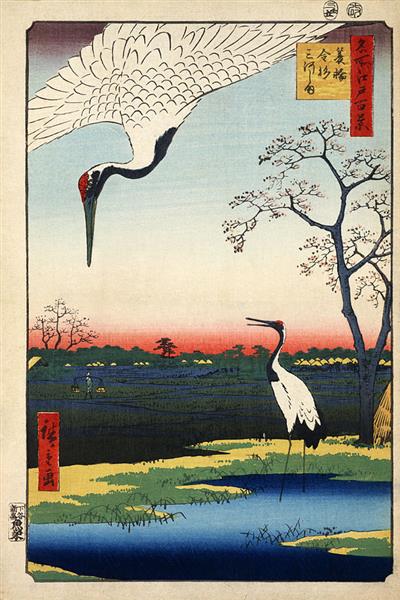Opis
The work “102. Minowa - Kanasugi And Mikawashima” by Utagawa Hiroshige, created in 1857, exemplifies the artist's mastery in creating landscapes that combine deep emotion with naturalistic representation. Hiroshige, one of the last great masters of ukiyo-e, e, the art of Japanese printmaking, is noted for its ability to capture the essence of its surroundings, transforming everyday beauty into a visual and emotional experience.
The composition of this work is notable for its elegant balance and harmony. Hiroshige employs an industrial arrangement that invites the viewer to explore the landscape: from the foreground, where lush flora is present, to the background, where gentle hills are outlined. This play of perspective not only creates depth, but also establishes a visual narrative. The different layers of the work convey a sense of distance and the passage of time, fundamental to Japanese landscape art.
In terms of colour, Hiroshige uses a delicate and subtle palette, with greens and blues predominating, evoking the calm and serenity of the Japanese landscape. Soft tones are intertwined with more intense touches that enhance certain elements, suggesting variations in light and atmosphere. This chromatic approach not only achieves an aesthetic visual effect, but also reflects the symbolism associated with nature, a central concept in Japanese thought, where each hue can be interpreted as a reflection of the emotional state of the environment.
The characters in this painting are, in fact, subtle but present. A group of tiny figures, seemingly moving along a meandering path, adds a sense of scale to the landscape and suggests an intimate connection between humans and nature. This inclusion, characteristic of many of his works, speaks to the interplay between everyday life and the natural elements that surround individuals in Japan, emphasizing a focus on the simple and ephemeral nature of existence.
Hiroshige’s historical context also enriches the reading of this work. In a period of transformation and modernization in Japan, his art becomes a refuge and a celebration of the traditional landscape. Hiroshige’s works served as an inspiration not only to his contemporaries, but also to later generations of artists, both in Japan and in the West. This link between nature, humans and the urban landscape reflects a specific time in art history, when ukiyo-e was beginning to be recognized internationally.
Hiroshige's style, with its focus on detail and innovative use of perspective and colour, also establishes a dialogue with other contemporary artists, such as Katsushika Hokusai. Both artists shared a desire to depict the beauty of nature, although each with his own uniqueness and personal vision.
“102. Minowa – Kanasugi and Mikawashima” is therefore a fascinating representation of Hiroshige’s ability to transform everyday realities into sublime art. His ability to balance meticulous detail with a broader visual narrative invites the viewer not only to contemplate the painting, but to immerse themselves in the story and feeling it evokes. This work is a testament to Hiroshige’s legacy, enduring as an icon of Japanese aesthetics and a tribute to the consultative landscape of his time.
KUADROS ©, a famous painting on your wall.
Hand-made oil painting reproductions, with the quality of professional artists and the distinctive seal of KUADROS ©.
Painting reproduction service with satisfaction guarantee. If you are not completely satisfied with the replica of your painting, we will refund 100% of your money.

